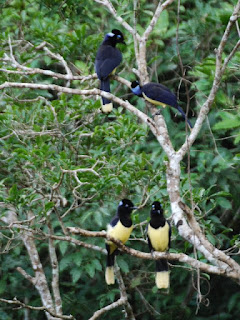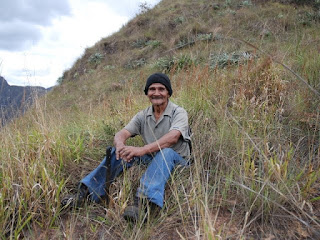A few days that have not quite gone according to plan and our research, and we are currently based in Santa Cruz for a couple of nights. Stomach bugs are just a part of this type of travel in South America, and after my extended struggle in the highlands of central Peru, Heather has not had a good response to Bolivian food. Our stay at the wildlife rehabilitation centre lasted just one night of camping. On arrival we were surprised to find a small army of 50+ volunteers already there, and we spent part of the afternoon helping with construction work - not at all what we aniticipated. Our bus trip yesterday was miserable lasting 12.5 instead of the planned 5 hrs. Three extended stops for flat tyres with the bus having no spares. The Lonely Plant travel guide notes the pessimism, melancholy and sometimes rebellion of Argentinians that has been shaped by the historic political turmoil of the country. Our experience is that this is also directly applicable to Bolivia, who maybe just in the last couple of years, finally has a president who is working for the people of the country. Nearly 200 changes in government in its last 181 years as a republic. In general, though with exceptions, we have had little of the friendliness and helpfulness we found in Peru. Bolivia is also very run down, and it is obvious that it is the poorest of the South American countries. Very sad when we have experienced just a small slice of the magnificent natural areas in the country, epitomised by the Madidi National Park with one of the greatest biodiversities in the world (over 10% of the world´s bird species), and a variety of indigenous cultures.
 A further 19 hour bus ride brought us south to Buenos Aires, the capital of Argentina, where we arrived yesterday. We had read in our Lonely Plant travel guide about the tradition in Uruguay of many restaurants serving gnocchi on the 29th of each month, just before pay day. Why our obsession ? Well, it is Heather´s favourite dish ! We didn´t quite make it to Uruguay in time, although we intend travelling there for a few days. We discovered that many restaurants in downtown Buenos Aires follow the same routine, and last night filled ourselves with enough to spare to cover for lunch today. Buenos Aires so far is fantastic, with many historic buildings, parks and green areas, ornate churches, restaurants and cafes, and some very friendly people. Astonishingly we have found some downtown accommodation that is cheaper than any other place in Argentina on our travels so far (and it is school holidays). We have already walked for hours, and seen amongst other sites the pink palace (Casa Rosada), where Eva Peron, and many subsequent political leaders, have given famous speeches to the crowds from the balcony.
A further 19 hour bus ride brought us south to Buenos Aires, the capital of Argentina, where we arrived yesterday. We had read in our Lonely Plant travel guide about the tradition in Uruguay of many restaurants serving gnocchi on the 29th of each month, just before pay day. Why our obsession ? Well, it is Heather´s favourite dish ! We didn´t quite make it to Uruguay in time, although we intend travelling there for a few days. We discovered that many restaurants in downtown Buenos Aires follow the same routine, and last night filled ourselves with enough to spare to cover for lunch today. Buenos Aires so far is fantastic, with many historic buildings, parks and green areas, ornate churches, restaurants and cafes, and some very friendly people. Astonishingly we have found some downtown accommodation that is cheaper than any other place in Argentina on our travels so far (and it is school holidays). We have already walked for hours, and seen amongst other sites the pink palace (Casa Rosada), where Eva Peron, and many subsequent political leaders, have given famous speeches to the crowds from the balcony.






















